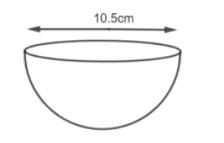
Answer
471k+ views
Hint: We have the diameter of the hemispherical bowl as 10.5 cm. We can use the formula \[r=\dfrac{D}{2}\] to find the radius. Then using the radius, we can find the surface area of the hemisphere using \[S=2\pi {{r}^{2}}.\] Once we have the surface area, the total cost is given by multiplying it with the cost per \[c{{m}^{2}}.\]
Complete step-by-step answer:
We are given a hemisphere whose inner diameter is 10.5 cm.

We will first find the radius. We know that diameter is defined as two times the radius.
\[D=2r\]
So dividing both the sides by 2, we get,
\[\Rightarrow r=\dfrac{D}{2}\]
We are given that diameter = 10.5. So,
\[D=10.5cm\]
\[\Rightarrow r=\dfrac{D}{2}\]
\[\Rightarrow r=\dfrac{10.5}{2}\]
\[\Rightarrow r=5.25cm\]
Now, to find the cost, first, we will find the inner curved surface area of the hemisphere. We know that the surface area of the hemisphere is given as
\[S=2\pi {{r}^{2}}\]
Here, r = 5.25 cm. So, we get,
\[\Rightarrow S=2\times \pi \times {{\left( 5.25 \right)}^{2}}\]
Expanding the above terms, we get,
\[\Rightarrow S=2\times \dfrac{22}{7}\times 5.25\times 5.25\]
Solving the above equation further, we get,
\[\Rightarrow S=173.25c{{m}^{2}}\]
Therefore, the surface area of tin plating \[=173.25c{{m}^{2}}.\]
Now, we are given that the cost of tin plating is Rs. 16 for \[100c{{m}^{2}}.\] That is,
\[Rs.16=100c{{m}^{2}}\]
So by the unitary method, we will find the cost of \[1c{{m}^{2}}.\]
As
\[100c{{m}^{2}}=Rs.16\]
\[\Rightarrow 1c{{m}^{2}}=Rs.\dfrac{16}{100}\]
Now, we will find for \[173.25c{{m}^{2}}.\]
\[\Rightarrow 173.25c{{m}^{2}}=\dfrac{16}{100}\times 173.25\]
\[=Rs.27.72\]
Therefore, the cost of tin plating the inner hemispherical bowl is Rs. 27.72.
Note: Students should not forget to convert the diameter to the radius, then only we could find the surface area. Also, do not multiply the surface area with 16, which is the total cost for 100. So, we have to divide it with 100 as well, then only we will get our required answer, else we would end up with the wrong answer.
Complete step-by-step answer:
We are given a hemisphere whose inner diameter is 10.5 cm.

We will first find the radius. We know that diameter is defined as two times the radius.
\[D=2r\]
So dividing both the sides by 2, we get,
\[\Rightarrow r=\dfrac{D}{2}\]
We are given that diameter = 10.5. So,
\[D=10.5cm\]
\[\Rightarrow r=\dfrac{D}{2}\]
\[\Rightarrow r=\dfrac{10.5}{2}\]
\[\Rightarrow r=5.25cm\]
Now, to find the cost, first, we will find the inner curved surface area of the hemisphere. We know that the surface area of the hemisphere is given as
\[S=2\pi {{r}^{2}}\]
Here, r = 5.25 cm. So, we get,
\[\Rightarrow S=2\times \pi \times {{\left( 5.25 \right)}^{2}}\]
Expanding the above terms, we get,
\[\Rightarrow S=2\times \dfrac{22}{7}\times 5.25\times 5.25\]
Solving the above equation further, we get,
\[\Rightarrow S=173.25c{{m}^{2}}\]
Therefore, the surface area of tin plating \[=173.25c{{m}^{2}}.\]
Now, we are given that the cost of tin plating is Rs. 16 for \[100c{{m}^{2}}.\] That is,
\[Rs.16=100c{{m}^{2}}\]
So by the unitary method, we will find the cost of \[1c{{m}^{2}}.\]
As
\[100c{{m}^{2}}=Rs.16\]
\[\Rightarrow 1c{{m}^{2}}=Rs.\dfrac{16}{100}\]
Now, we will find for \[173.25c{{m}^{2}}.\]
\[\Rightarrow 173.25c{{m}^{2}}=\dfrac{16}{100}\times 173.25\]
\[=Rs.27.72\]
Therefore, the cost of tin plating the inner hemispherical bowl is Rs. 27.72.
Note: Students should not forget to convert the diameter to the radius, then only we could find the surface area. Also, do not multiply the surface area with 16, which is the total cost for 100. So, we have to divide it with 100 as well, then only we will get our required answer, else we would end up with the wrong answer.
Recently Updated Pages
Fill in the blanks with suitable prepositions Break class 10 english CBSE

Fill in the blanks with suitable articles Tribune is class 10 english CBSE

Rearrange the following words and phrases to form a class 10 english CBSE

Select the opposite of the given word Permit aGive class 10 english CBSE

Fill in the blank with the most appropriate option class 10 english CBSE

Some places have oneline notices Which option is a class 10 english CBSE

Trending doubts
Fill the blanks with the suitable prepositions 1 The class 9 english CBSE

How do you graph the function fx 4x class 9 maths CBSE

When was Karauli Praja Mandal established 11934 21936 class 10 social science CBSE

Which are the Top 10 Largest Countries of the World?

What is the definite integral of zero a constant b class 12 maths CBSE

Why is steel more elastic than rubber class 11 physics CBSE

Distinguish between the following Ferrous and nonferrous class 9 social science CBSE

The Equation xxx + 2 is Satisfied when x is Equal to Class 10 Maths

Differentiate between homogeneous and heterogeneous class 12 chemistry CBSE




